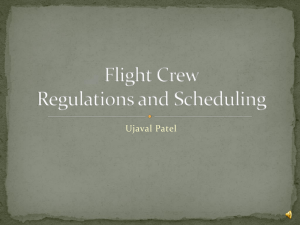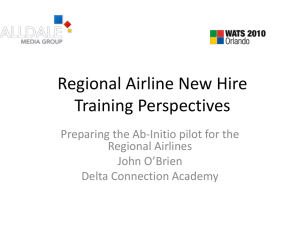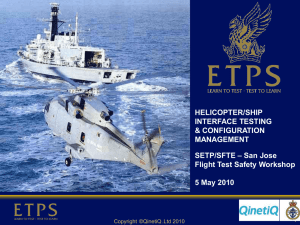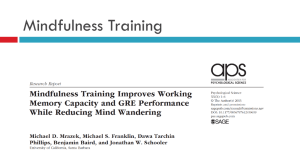Operational Policies and Training?
advertisement
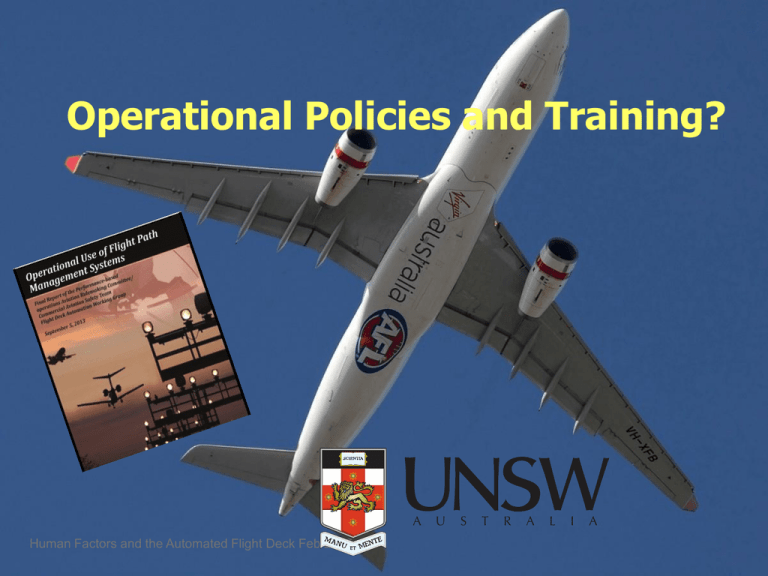
Operational Policies and Training? Human Factors and the Automated Flight Deck Feb 2015 Aviation system is very safe Pilots (and others) often mitigate operational risk Improvements have been made but vulnerabilities found in areas including: Manual handling Interaction with automated systems Pilot training/qualification training/qualification Human Factors and the Automated Flight Deck Feb 2015 Operational Operational policies/procedures policies/procedures Integration with air traffic services/airspace Human Factors and the Automated Flight Deck Feb 2015 Changing Skills! Scope of Operations Advanced Advanced Normal Basic/ Contingency Normal Normal Crew Coordination, Problem Solving, and Manual Handling Skills 1960’s Timeframe Human Factors and the Automated Flight Deck Feb 2015 2000’s Operational Policy Findings Recommendations (#9) Improvements, but … Flight path management Focus No Common Terminology Type of Operation Opportunities for Manual Flight Focus on the TASK not the Emphasis on crew communicationautomation and Wide Variation Compliance with Policy consistent with crosscheck (e.g., SOPs has been training practice (#1) Focus and on Modes verbalize, verify, Guidance: Selection to drive emphasised F’Path … monitor)Who/what is controlling Control: One Size does NOT fit all No One BEST Reflect Operator / Integral / Dynamic (Review) / Manufacturer / Training Meaning / Terms / Guidelines / Policy + Procedures (#3) Human Factors and the Automated Flight Deck Feb 2015 Not about name (FCU, Long / Short Haul MCP) Mixed Fleet … but don’t always Automation as pilots a tool Philosophy and Policy History / Culture follow Pilot Experience • and Operational Guidance Control match • Workload • Too prescriptive “unable” • Environment Pay-off Weather / Terrain / Adapt to the operator Infrastructure / ATC IFR / VFR Consistent Terminology Information Management X-Checking? Low payoff Onerous / Repetitive Conflicting Goals Understanding Poor XCheck Human Factors and the Automated Flight Deck Feb 2015 Normative Guidance and Control – Crew Workload Less MANAGED Autoflight with FCU Manual flight with FD guidance Manual flight without FD guidance Crew Workload Greater Human Factors and the Automated Flight Deck Feb 2015 Automation Pyramid Guidance and Control – Levels Aircraft reaction time FMS FCU/MCP “HEAD UP” SHORT INTERACTION SHORT TERM ACTION Basic Human Factors and the Automated Flight Deck Feb 2015 “HEAD DOWN” LONG INTERACTION LONG TERM ACTION Interaction time Pilot Vulnerability Why? Abdicate too much responsibility • Lack of self efficacy • Policies • Insufficient training/experience/judgment Human Factors and the Automated Flight Deck Feb 2015 Result: pilots may not be prepared to handle non-routine situations 9 Captain Simon Henderson Virgin Australia simon.henderson@virgin australia.com FCL Briefing APR 2014 CASA FOI Briefing May 2012 Human Factors and2the Automated Flight Deck Feb 2015 INITIAL TRAINING RECURRENT TRAINING Reinforce Human Factors and the Automated Flight Deck Feb 2015 LINE OPERATIONS Finding 11 - Pilot Knowledge and Skills for Flight Path Management Pilots sometimes lack sufficient or in-depth knowledge and skills to most efficiently and effectively accomplish the desired flight path management related tasks. Pilot Feedback on FMS Training • 2/3rd report difficulties in first 6 months • Only ¼ felt adequately prepared • 42% - training was deficient • 62% - 3-12 months to feel comfortable Human Factors and the Automated Flight Deck Feb 2015 Inadequate Pilot Knowledge (from accident/major incident data) Understanding of flight director, autopilot, autothrottle/autothrust, and flight management system/computer: Knowledge of systems and limitations Operating procedures Need for confirmation and crosscheck Mode transitions and behavior Crew Resource Management Unusual attitude recognition and recovery, including high altitude Speed and energy management Human Factors and the Automated Flight Deck Feb 2015 Consequences for Flight Path Management • Depth of Systems Knowledge • Required to anticipate, monitor, and react Knowledge Issues Practice and Exposure Deviation and Offpath mgt Understdg of underlying Systems • Training is often limited, flightcrews manage/react in variable ways Human Factors and the Automated Flight Deck Feb 2015 • How modes and selections relate to flight path management task Finding 12 - Current Training Time, Methods, and Content Current training methods, training devices, the time allotted for training, and content may not provide the flightcrews with the knowledge, skills and judgment to successfully manage flight path management systems. Challenging Areas • The most prevalent challenge described was that of balancing the program focus on developing and maintaining skills using the automated systems and those related to flying and making decisions without those automated systems. • Train departures and arrivals, including realistic line-oriented scenarios Human Factors and the Automated Flight Deck Feb 2015 Finding 13: Instructor Trg & Qual Flight instructor training, experience, and line-operation familiarity may not provide the required flight instructor experience and skills to effectively train flightcrews for successful flight path management. This will be especially important for future operations. Improvements Required • Instructors stated improvement is needed for training and developing instructor skills. • Many airlines do not provide specific training for the instructors on how to teach automated systems. • Many instructors stated they would benefit from better instructor training on how to teach the use of automation as well as instruction on the underlying principles and intricacies of how the automation works. Human Factors and the Automated Flight Deck Feb 2015 Recommendations Regulatory guidance and requirements for training should be expanded to address: Flight path and energy management throughout the flight regime Recovery from off-path circumstances The use of alternative modes to meet air traffic clearances/requirements Training to meet the operators’ operational policies Moving between basic and more advanced automated system modes The decision-making process concerning the selection of applicable modes Human Factors and the Automated Flight Deck Feb 2015 Recommendations Regulatory guidance and requirements for training should be expanded to address: Actions to be taken when the desired aircraft performance does not match that provided or scheduled by the automated systems. Include actions and the requirement to advise air traffic when applicable Handling known automated system anomalies or situations known to cause crew difficulties The conduct of normal go-arounds Distraction and workload management Malfunction management Human Factors and the Automated Flight Deck Feb 2015 Recommendations Regulators should consider: Training and qualification requirements for trainers How the requirements for training specified during the introduction of new technology, procedures or practices may be amended following the integration of these new elements into normal operations Regulators should address how the following areas are specified in the syllabus, content and conduct of training/qualification in flight path management systems; The levels of skill and knowledge to be demonstrated The mix of training required with particular emphasis on the elements to be addressed during line training The promotion and retention of manual handling skills Human Factors and the Automated Flight Deck Feb 2015 Captain Dave McKenney United Airlines / ALPA.I Human Factors and the Automated Flight Deck Feb 2015

